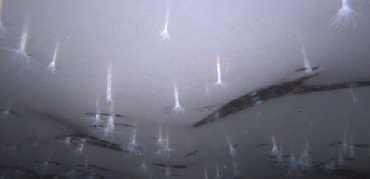ice-anemones.jpg

Anemones protrude from the bottom surface of the Ross Ice Shelf. Credit: Frank R. Rack, ANDRILL Science Management Office, University of Nebraska-Lincoln.
Sometimes scientists searching for one thing stumble unexpectedly onto another. A few years ago, a research team did just that, they drilled into an Antarctic ice sheet and opened up a can of anemones — almost literally. When the Antarctic Geological Drilling (ANDRILL) Program lowered a 4.5- foot cylindrical robot through the ice off the coast of west Antarctica, they were hoping to use the robot’s two cameras to learn about ocean currents while gathering data for modeling the drill’s use. In the process, their cameras captured an icy garden of sea anemones that no one knew existed.
Thousands of white anemones, each with 20 to 24 tentacles and ranging from one to four inches long, clung underneath to the Ross Ice Shelf. The newly discovered species, named Edwardsiella andrillae, is the first anemone found to live on the ice — and hang upside down — rather than on the sea floor like other anemones. The discovery inspired a whole list of questions: How do they avoid freezing? How do they reproduce? What do they eat?
The researchers also found fish under the ice swimming upside down, below their “ocean floor” of ice anemones and accompanied by worms, small crustaceans called amphipods, and even a cylindrical creature the scientists called “the eggroll,” which bumbled through the anemone garden and sometimes even clung to them.
The team of geologists doing the drilling did not expect a discovery of animal life, so biologists will need to return to learn more about the anemones and the bizarre, ecosystem in which they live. They should have plenty to study in this surprising icy ecosystem.


